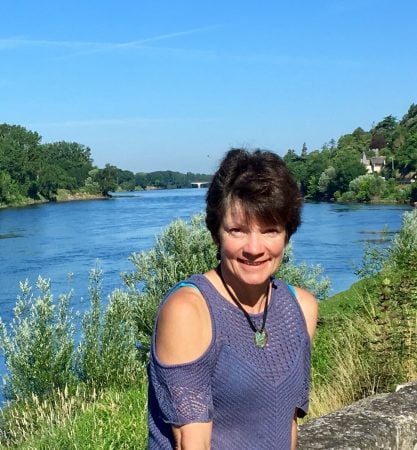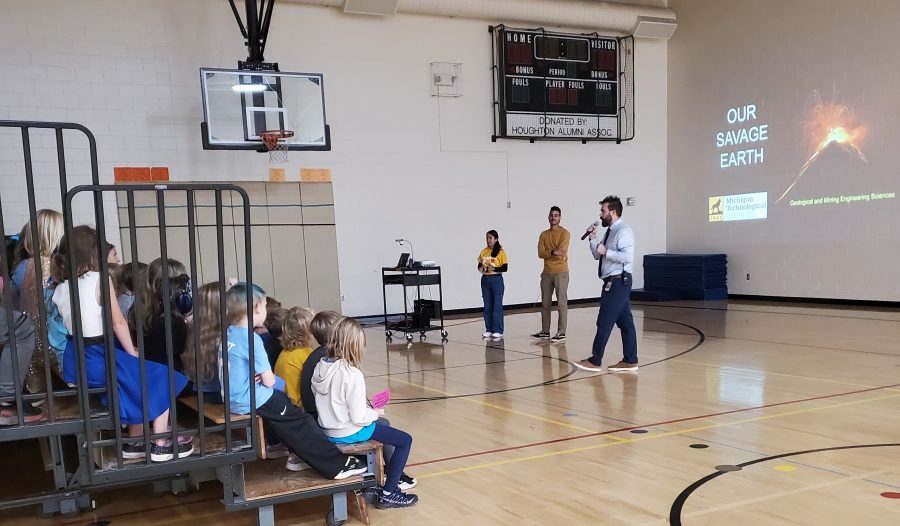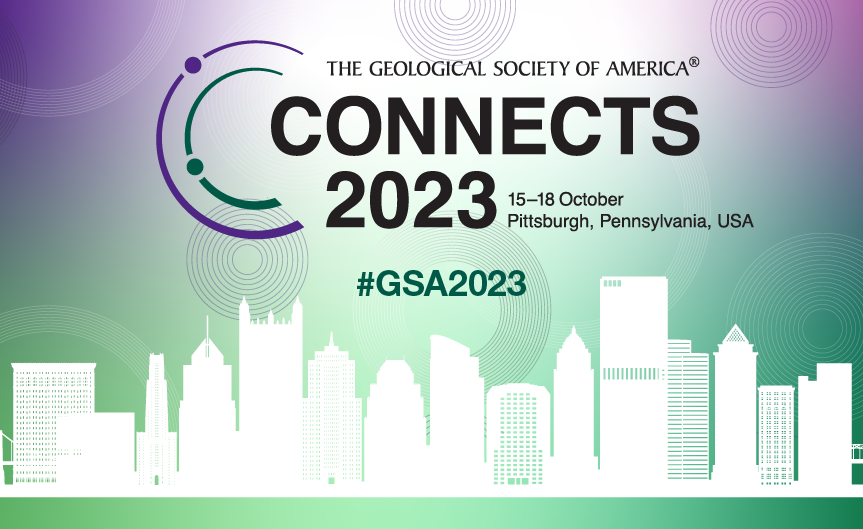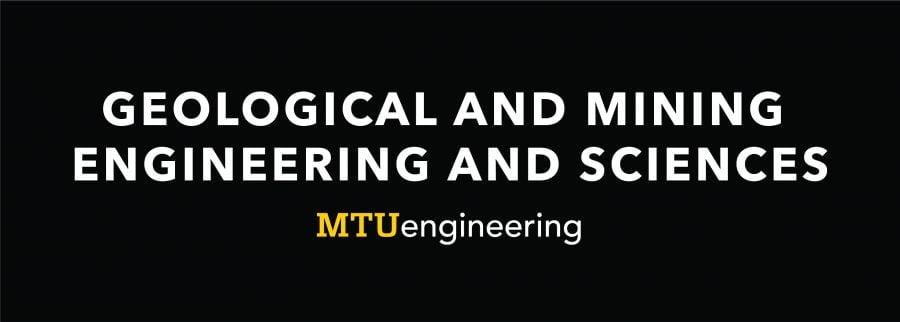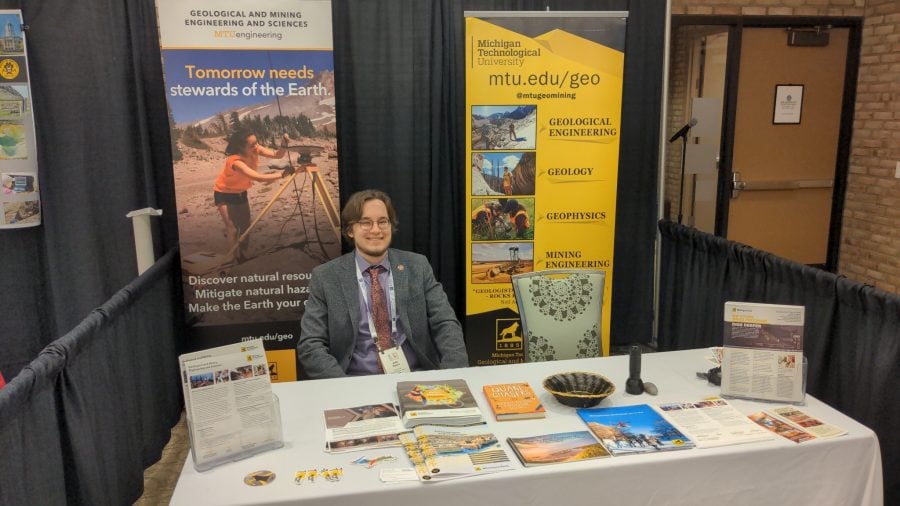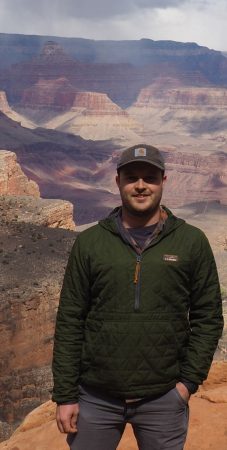Mary Herrmann-Foley, MBA, returns to campus as the EPSSI Seminar guest speaker on Monday, October 23, 2023, from 4 – 5 p.m. in M&M room U113. Mary completed her Bachelor’s Degree in Geological Engineering at Michigan Tech in 1983. She continued her education at the University of Houston, earning her master’s in business administration in international finance in 1985. Currently, she serves as Manager of Central Support PetroSigns SSW application at Shell. Last fall, Mary was inducted into the Academy of Geological and Mining Engineering and Sciences. We are excited to welcome her back to campus once again!
In her talk, Role of Subsurface Engineering and Geology in the Energy Transition World, she will discuss the essential role of subsurface engineering and geology in the changing world of energy transition.
From the abstract: The world is in the midst of the first “truly global energy crisis,” the International Energy Agency (IEA) said in its World Energy Outlook in October 2022. It’s multidimensional and comes with the challenge of global warming and the need to reduce/eliminate CO2 emissions. We are all experiencing the impact of rising CO2 in the atmosphere: ocean levels rising, more intense storms, and increasing temperatures with corresponding implications on us and the environment around us. Conflicting pressures linked to continued high-energy demand, the need for energy security, and the imperative for reducing CO2 emissions are driving unprecedented renewable energy growth. This presentation will touch on the challenges related to these conflicting pressures and how existing and start-up energy companies are addressing some of these challenges through numerous renewable energy and carbon sequestration options, mainly focusing on the crucial role subsurface engineering and geology can play in this journey. Highlights of Michigan’s current situation and related business opportunities will also be discussed.
All are welcome to attend.
We are delighted to recount the recent visit of two Geological and Mining Engineering and Sciences (GMES) students to Houghton Elementary School, where the Rock Your School event sparked geologic wonder. Jhuleyssey Sanchez Aguila, an MS student in geological engineering, and applied geophysics undergrad student Brendan Harville took center stage as they masterfully conducted a captivating presentation on volcanic hazards, capturing the imaginations of the bright minds in the third, fourth, and fifth grades.
It was an immensely gratifying experience for all involved as the students exhibited an insatiable curiosity, inspiring questions that underscored their genuine interest in the particularities of geological science. The eagerness displayed by the young learners further reinforced the value of fostering scientific curiosity at an early age. This collaborative effort between our university and the elementary school enriched the children’s educational experience. It exemplified the profound impact that dedicated mentorship and knowledge-sharing can have on the budding scientists of tomorrow. TV6 gives a nod to Michigan Tech in the concluding comments of their news segment.
A special thank you to Jhuleyssey and Brendan!
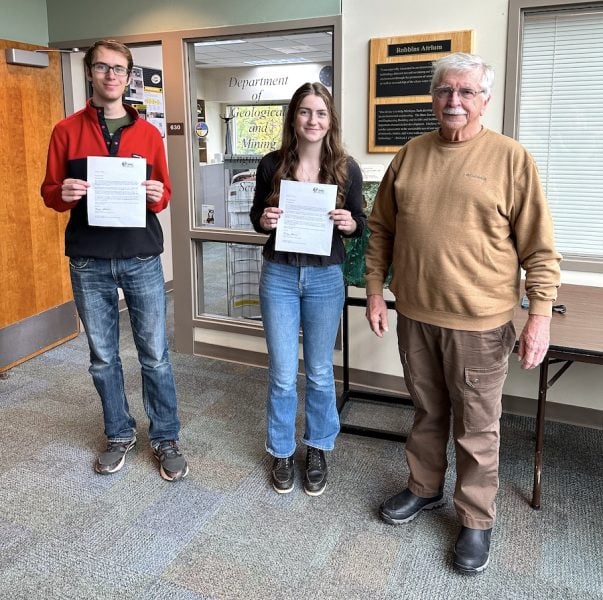
Lydia Lamey, a senior in Applied Geophysics and Sean Miller, a junior in Geological Engineering, were awarded the Copper Country Rock and Mineral Club (CCRMC) DeCleene Memorial scholarship for the 2023–2024 academic year. This scholarship is for students in the Department of Geological and Mining Engineering and Sciences at Michigan Tech who have demonstrated excellent academic performance, and best exemplify the blending of mineralogy and mineral collecting as both a hobby and an educational pursuit.
The scholarship was established in memory of Nathan DeCleene, a geological engineering student and an active member of the CCRMC.
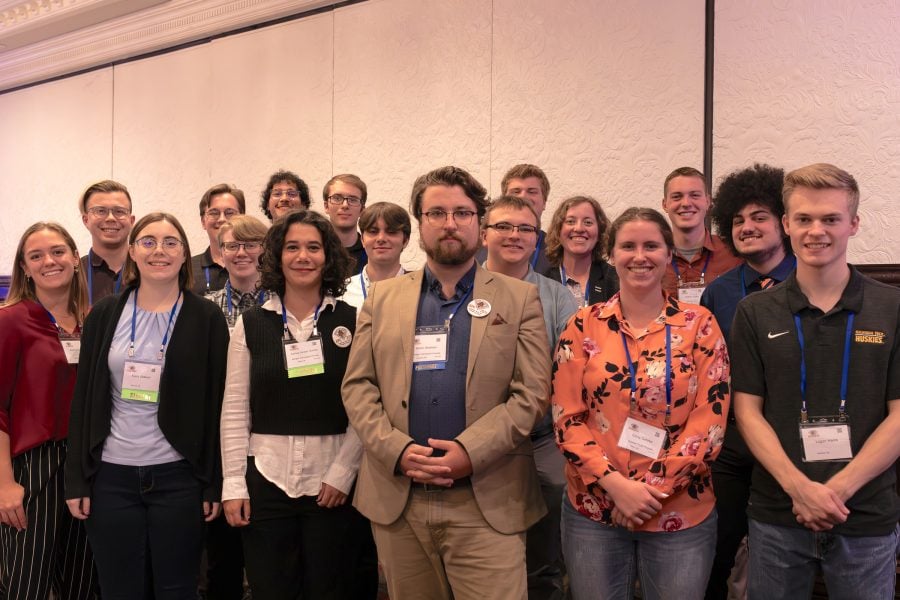
Professional development often means enduring challenges. For GMES students, not even the hardships of staying at campgrounds or incredibly long drives can deter them!
Sixteen GMES students recently marked their presence at the 60th Anniversary National Conference of the American Institute of Professional Geologists (AIPG) held in Covington, Kentucky, from September 16-19. Throughout the conference, the students gained insights into the organization and functions of AIPG, engaged in a Student Career Workshop, and networked with seasoned AIPG professionals.
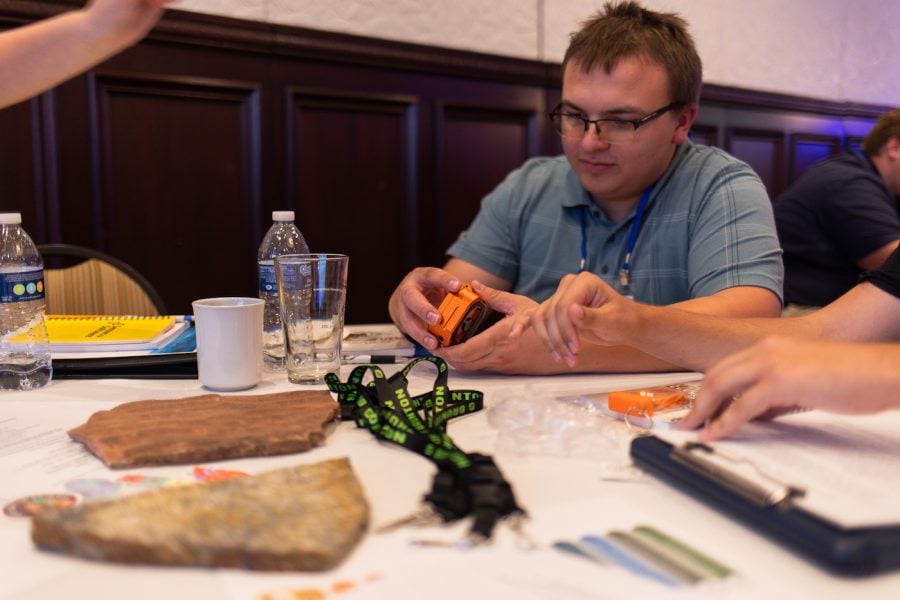
The students attended presentations by a mining geologist, a National Park geoscientist, and a geotechnical contractor, and asked questions regarding their respective fields. One of those students was Anton Smirnov (Geology ‘24). “It was a great way to learn about the wide range of fields available to graduates in geological sciences,” he said.
Students were treated to a technical seminar by Brunton, Wyoming-based maker of precision equipment for field-based professionals. Students also received some hands-on time with the company’s products. Samuel Johnson shared: “The demonstration of how the different models of compasses worked was a great educational experience, especially for students who haven’t used these compasses before.”

Finally, the chapter took part in a meet-and-greet event. The students rotated between tables of professionals and scientists specializing in various fields in geology and geological engineering. They also met with Kalan Briggs, the AIPG Michigan Section President; Adam Heft, the AIPG Michigan Section Newsletter editor; and Michigan Tech alumnas Sienna Meekhof (BS Geology ‘21) and Elana Barth (MS Geology ’23).
Barth is former president of Michigan Tech’s AIPG Student Chapter. She is now a geologist at AECOM, and generously assisted with accommodations for several students. However, embodying the true spirit of geoscientists, the majority of the students opted to stay at a campground near Covington.
All in all it was a rewarding time for the students. “Attending the 60th AIPG National Conference in Covington was a fantastic experience,” said applied geophysics major Brendan Harville. “I was able to speak with numerous professionals from a variety of geology industry disciplines, who not only provided insight into their own non-linear career paths, but also a great deal of excellent advice.”
The trip was organized and funded by the Michigan Tech AIPG Student Chapter: President Anton Smirnov, Vice President Clarissa Gordon, Treasurer Conor Large, and Secretary Brendan Harville.
This year the Michigan Tech GMES chapter was selected as the Second Place 2023 AIPG Student Chapter of the Year. The MTU chapter sponsor is David Adler, CPG-11377, a Mannik Smith Group Certified Professional Geologist (BS Geology ‘82).
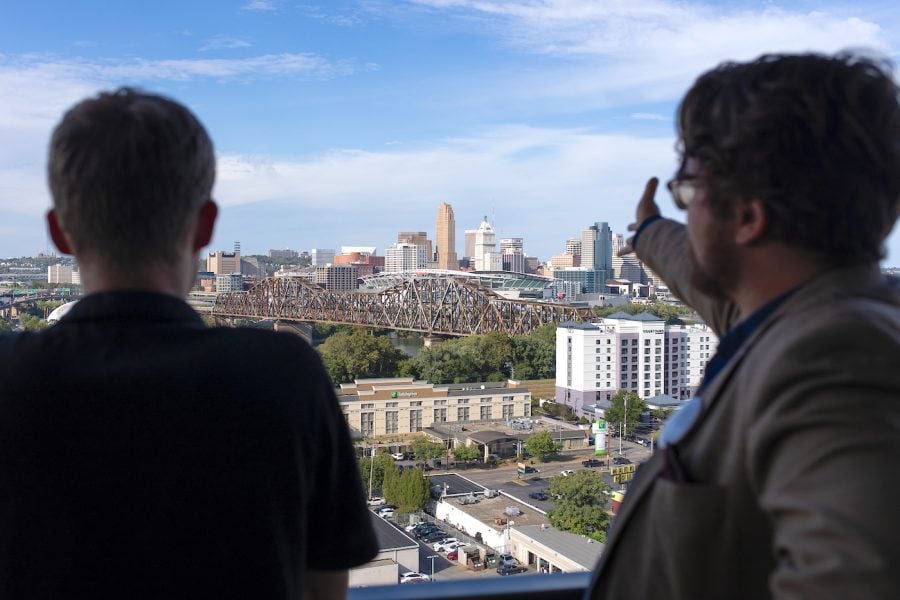

Will you be in Pittsburgh for GSA Connects 2023? Please join us on Monday evening for the Michigan Colleges/Universities Joint Alumni reception (Albion, CMU, EMU, GVSU, Hope, Michigan Tech, WMU, and WSU). Enjoy snacks and a cash bar.
Monday, October 16, 2023
5:30 PM – 7:30 PM
Sky Room, 17th floor
Omni William Penn Hotel
Questions? Contact Aleksey Smirnov, GMES Chair. We hope to see you there!
For some families, the impact of Michigan Tech can be felt generations later. That is the case with the Walter Wickstrom ’37 family.
Three of Walter’s children, Betty Wickstrom Kendrick, Jean Wickstrom Liles, and Phil Wickstrom—none of whom are Michigan Tech alumni or live anywhere close to Michigan Tech—all fund scholarships in memory of their father and to support Tech, which they credit with setting up their family for success.
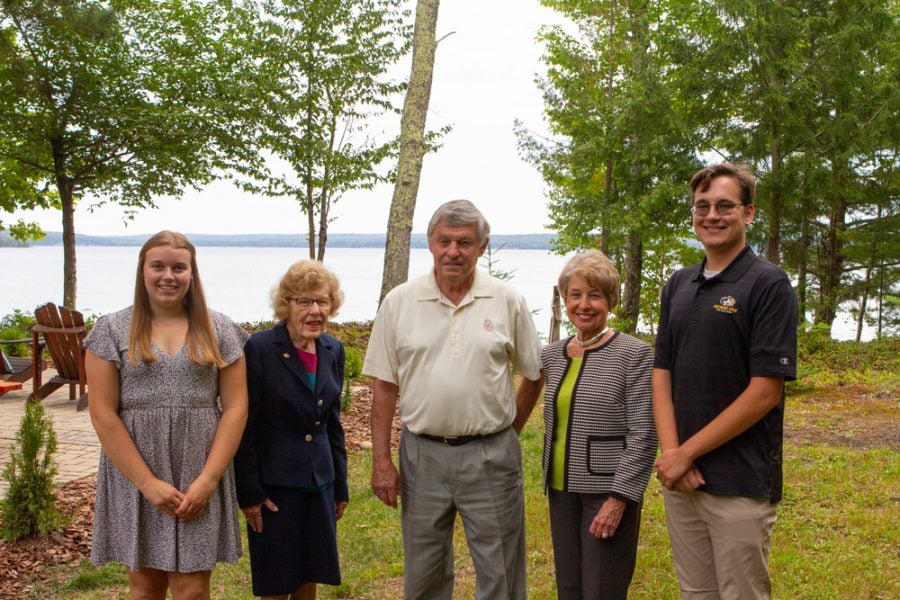
Walter Wickstrom Sr. earned a mining engineering degree from Michigan Tech in 1937 (then called the Michigan College of Mining and Technology).
Read more at Michigan Tech Alumni News, by Wes Frahm.
Related
Geological engineering student John Myaard interviewed for an internship with Covia Corporation during a Michigan Tech Career Fair, and landed the job.
“Covia develops mineral-based and material solutions for the materials and energy markets. I spent a summer with Covia’s operations team at their mine and plant in Roff, Oklahoma. During my time there I learned a lot about operations as I worked in a variety of positions—from slurrying sand to loading railcars and everything in between. I also completed new miners training: MSHA Part 46 Certification, required by the U.S. Department of Labor.
“My time at Tech has been influential. I’ve met many good peers with whom I’ve weathered both the classroom and the elements.”
“Michigan Tech was always on my radar. I am from Michigan and grew up in Hudsonville, home to Hudsonville ice cream. I had family in the UP, so I’d already had a chance to see the MTU campus. Originally I was going to major in computer science, but after being exposed to some geology courses in high school and then experiencing a favorable tour of the GMES Department, I decided geological engineering would be a better fit.”
“I’m passionate about the interdisciplinary problem solving required in the field of mining. I see a lot of value in geological engineers getting involved with operations and mineral processing. We bring a diverse set of skills to the table.”
“There are more opportunities within the geological disciplines than most people are aware of. Especially now, as I am looking to graduate, many diverse career options exist, and the future of the discipline looks good.”
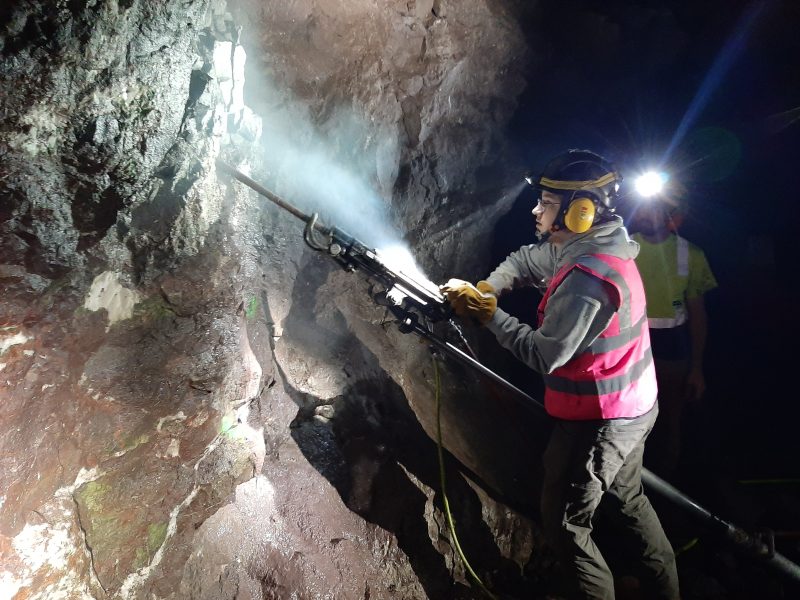
“The Career Fair is not only a great resource for students to find new opportunities, it’s a great place to receive professional development, as well. I took part in several callback interviews that helped me develop and improve my interview skills. The callbacks were instrumental in landing my internship, and hopefully in launching my future career.”
“There is no singular path for success. It is a journey, try your best.”
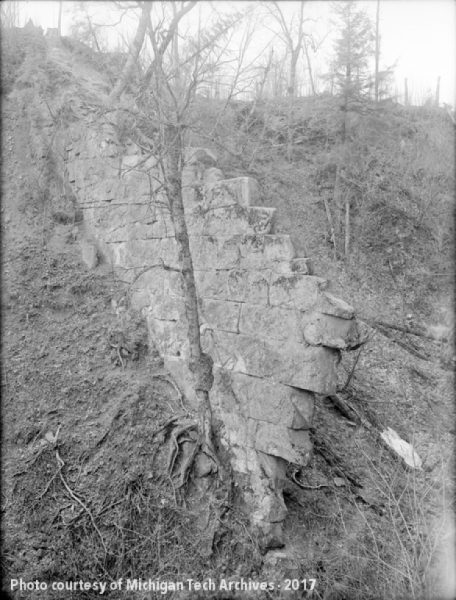
AIPG, the American Institute of Professional Geologists, recognized the student chapter at Michigan Tech as one of the outstanding student chapters in the nation this past year. The chapter is highly deserving of this distinction and honor and was selected as the Second Place 2023 AIPG Student Chapter of the Year.
The award consists of a certificate to be presented to the student chapter, and a certificate to each of the standing chapter officers at the time of the student chapter report submittal.
Some of the recent activities of the chapter involve field trips to mining foundations as well as to the Natural Wall, a geological structure formed of Jacobsville Sandstone.
The students are encouraged to attend the annual AIPG conference and meetings, which will be held next in Covington, Kentucky on September 16–19, 2023. During the conference, students will have the opportunity to observe the organization and functions of AIPG, participate in the Student Career Workshop, and attend a networking event with professional AIPG members.
The Chapter Sponsor is David Adler, CPG-11377, a Mannik & Smith Group Certified Professional Geologist (BS Geology ‘82). David Adler, inducted into the GMES Academy in October, has been awarded the AIPG Presidential Certificate of Merit for excellent contributions to the AIPG Michigan Section as chairman of the Michigan Section CPG application process.
The Chapter’s Faculty Sponsor is Chad Deering, associate professor in the Department of Geological and Mining Engineering and Sciences.
Related
Michigan Tech wins 2022 AIPG Student Chapter of the Year Award
The 2020 AIPG Student Chapter of the Year Award goes to Michigan Tech

Beth Bartel ’23 (Ph.D. Geology) is a co-author of a paper published in Frontiers in Earth Science.
The article is titled “Children first: women’s perspectives on evacuation at Fuego volcano and implications for disaster risk reduction.”
Ailsa Naismith of Bristol University is also a co-author.
The article was included as a part of a special research topic on “Women in Science: Volcanology” and is the first publication from Bartel’s dissertation work. The research was supported by committee members from both the Department of Geological and Mining Engineering and Sciences (GMES) and the Department of Social Sciences (SS).
On August 3, 2023, Ian Gannon successfully defended his geological engineering research for his MS degree.
Advised by James DeGraff, with Chad Deering and Aleksey Smirnov as committee members.
Title: Integrating LiDAR, Aeromagnetic, and Geological Field Data to Identify Structural-Lithologic Elements Within the Archean Carney Lake Gneiss Complex
Abstract: The Archean Carney Lake Gneiss Complex (CLGC) is a suite of rocks on the southern margin of the Superior Province and within the Minnesota River Valley subprovince. It is one of many gneissic domes in Michigan, Wisconsin, and Minnesota whose complex geology is poorly understood due to a previous lack of economic interest in gneissic terranes and significant challenges to their investigation. As a consequence, the CLGC and other gneissic domes in the region are represented on geologic maps as undifferentiated masses surrounded by better-defined and understood Paleoproterozoic supracrustal rocks and igneous intrusions. Within the last ten years, however, the United States has identified an urgent need to find new sources of critical minerals to sustain and grow the nation’s technology and defense industries, which has renewed interest in these very old and complex rocks. Under the Earth Mapping Resources Initiative (Earth MRI) of the U.S. Geological Survey, the CLGC and surrounding Paleoproterozoic rocks have been remapped to update geologic interpretations and to assist in identifying potential mineral systems in the region. Mapping of the CLGC was accomplished using traditional techniques combined with satellite-based phone applications and differential GPS devices to navigate in dense vegetative cover, to obtain accurate coordinates of field sites, and to collect geologic data at outcrops. As a further aid to ground mapping, high-resolution LiDAR and aeromagnetic data were analyzed to determine topographic and magnetic patterns and textures that potentially reflect structural-lithologic domains within the CLGC.
Integration of the new geologic field data with features and patterns identified on LiDAR and aeromagnetic maps allows definition of three domains within the CLGC: (1) a poly-deformed, mostly felsic gneiss with folded and sheared banding; (2) a meta-igneous, plagioclase-dominated gneiss with poorly expressed banding; and (3) a meta-sedimentary gneiss with thin well-developed banding and local relict sedimentary textures. Outcrop mapping also reveals the widespread occurrence and great variety of younger felsic and mafic intrusions that were not fully appreciated by earlier mappers. Data integration has allowed better definition of geologic unit contacts around the margins of the CLGC and within some Paleoproterozoic metasedimentary units, which updates knowledge about the Sturgeon Quartzite to the northeast and the Vulcan Iron Formation to the south. Although some analytical work is ongoing, such as radiometric age dating, the integrated mapping effort has identified between five to eight tectonomagmatic events that have affected the region, plus a number of sedimentary cycles. The abundance of processes that have affected the area provides multiple opportunities for concentration of mineral deposits that could be attractive for future exploration efforts. The data integration approach developed for this thesis project should be useful in identifying structural-lithologic domains within enigmatic Precambrian gneiss domes elsewhere in the region and globally.
